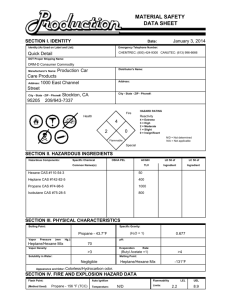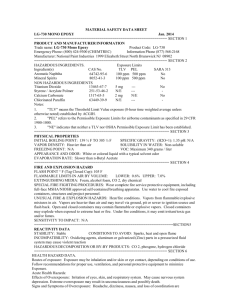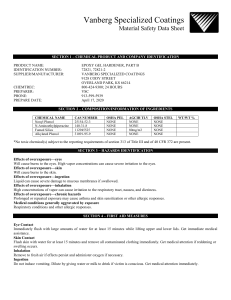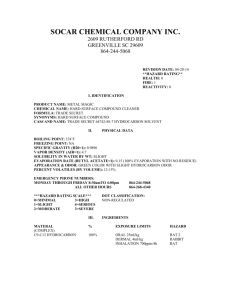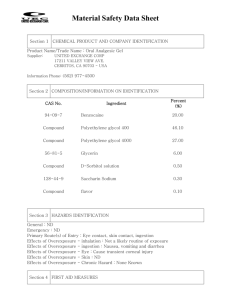Material Safety Data Sheet
advertisement
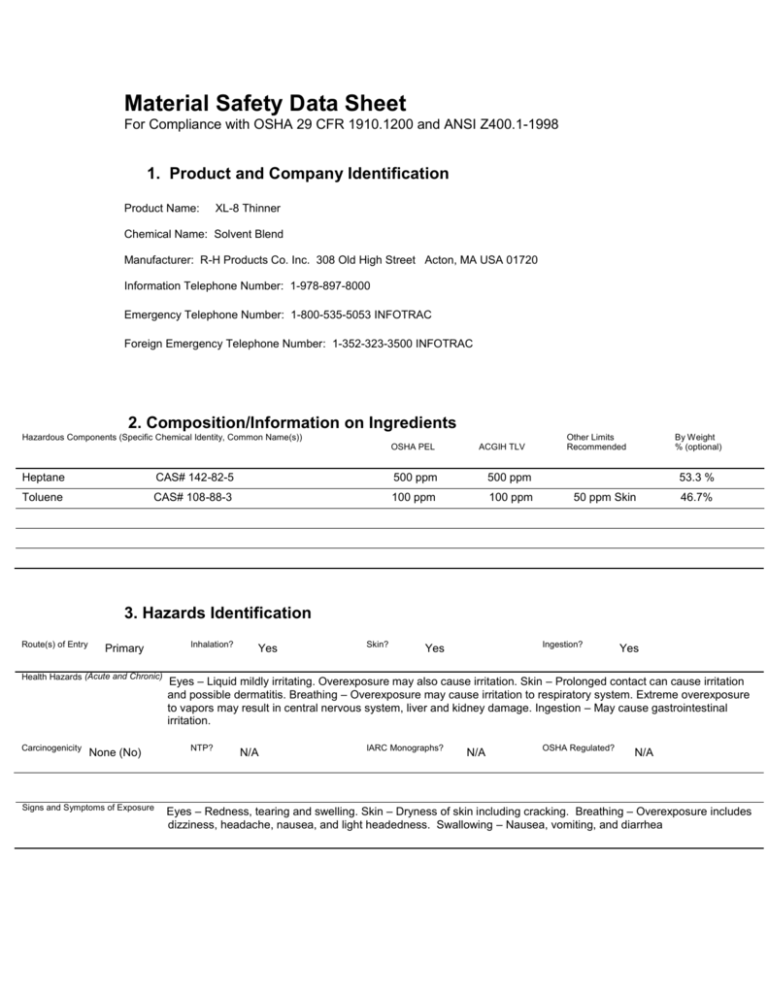
Material Safety Data Sheet For Compliance with OSHA 29 CFR 1910.1200 and ANSI Z400.1-1998 1. Product and Company Identification Product Name: XL-8 Thinner Chemical Name: Solvent Blend Manufacturer: R-H Products Co. Inc. 308 Old High Street Acton, MA USA 01720 Information Telephone Number: 1-978-897-8000 Emergency Telephone Number: 1-800-535-5053 INFOTRAC Foreign Emergency Telephone Number: 1-352-323-3500 INFOTRAC 2. Composition/Information on Ingredients Hazardous Components (Specific Chemical Identity, Common Name(s)) OSHA PEL ACGIH TLV Heptane CAS# 142-82-5 500 ppm 500 ppm Toluene CAS# 108-88-3 100 ppm 100 ppm Other Limits Recommended By Weight % (optional) 53.3 % 50 ppm Skin 46.7% 3. Hazards Identification Route(s) of Entry Primary Health Hazards (Acute and Chronic) Carcinogenicity None (No) Signs and Symptoms of Exposure Inhalation? Yes Skin? Ingestion? Yes Yes Eyes – Liquid mildly irritating. Overexposure may also cause irritation. Skin – Prolonged contact can cause irritation and possible dermatitis. Breathing – Overexposure may cause irritation to respiratory system. Extreme overexposure to vapors may result in central nervous system, liver and kidney damage. Ingestion – May cause gastrointestinal irritation. NTP? N/A IARC Monographs? N/A OSHA Regulated? N/A Eyes – Redness, tearing and swelling. Skin – Dryness of skin including cracking. Breathing – Overexposure includes dizziness, headache, nausea, and light headedness. Swallowing – Nausea, vomiting, and diarrhea Skin – Prolonged contact will irritate skin and may cause dermatitis. Breathing – Extreme overexposure to vapors may cause nervous system damage. Swallowing – May cause nausea, vomiting and diarrhea. Aspiration into the lungs as a result of vomiting may cause lung damage. Medical Conditions Generally Aggravated by Exposure 4. First Aid Measures Emergency and First Aid Procedures Eye contact – Flush immediately with water. Call a physician. Skin contact – Wash area with soap and water. Breathing – Move affected person to fresh air at once. Restore breathing. Call a physician if difficulties persist. If swallowed – DO NOT INDUCE VOMITING. Call a physician. Give water to victim. If vomiting occurs, prevent aspiration into lungs by lowering head between knees. 5. Fire Fighting Measures Flash Point (Method Used) 26F Heptane/45F Toluene ASTM D-56 Extinguishing Media FOAM, DRY CHEMICAL, CO2 Special Fire Fighting Procedures Flammable Limits LEL 1% UEL 7.5% Fire Fighters should be equipped with self-contained breathing apparatus when fighting fires involving this material. Unusual Fire and Explosion Hazards Extremely Flammable. Overheated, closed container near a fire could explode due to pressure buildup. 6. Accidental Release Measures Steps to Be Taken in Case Material Is Released or Spilled Extinguish all sources of ignition in area. Collect spilled material and place in a closed container for disposal or salvage. 7. Handling and Storage Precautions to Be Taken in Handling and Storing Other Precautions Keep away from heat; open flames and sparks. Use and store with adequate ventilation to prevent vapor buildup. Vapors released by product can easily ignite. Avoid contact with skin and eyes. Avoid prolonged breathing of vapors. Keep container closed when not in use. KEEP OUT OF REACH OF CHILDREN 8. Exposure Control/Personal Protection Respiratory Protection (Specify Type) Ventilation Local Exhaust Should be used to maintain exposure below TLV(s) Mechanical (General) Protective Gloves If exposure exceeds occupational exposure limits use a NIOSH approved respirator to prevent overexposure. Per 29 CFR 1910.134 CCROV or SA types recommended. Should be used to maintain exposure below TLV(s) Work/Hygienic Practices Explosion proof ventilation maybe required to control vapor concentrations. Other N/D Eye Protection Impervious gloves; (for Solvent) Other Protective Clothing or Equipment Special Chemical goggles or safety glasses Work apron to avoid contact with personal clothing and skin. Keep area clean. Wash hands thoroughly after working with product. 9. Physical and Chemical Properties Boiling Point Heptane (Component) Vapor Pressure (mm Hg) at 68O F Melting Point 40 mm Vapor Density (AIR = 1) Solubility in Water Specific Gravity (H20 = 1) 2090 F Evaporation Rate (Butyl Acetate = 1) Heavier Insoluble in water Appearance and Odor Normal Physical State: Liquid, clear with strong aromatic/gasoline like odor 10. Stability and Reactivity Stability Unstable Stable Incompatibility (Materials to Avoid) X N/A Oxidizing Agents Hazardous Decomposition or Byproducts Hazardous Polymerization Conditions to Avoid CO2 and CO when subjected to flames or excessive heat May Occur Conditions to Avoid Will Not Occur X N/A Approx. .75 -132 F Slower 11. Toxicological Information Route(s) of Entry: Skin contact, inhalation, eye contact and ingestion. Irritant. No other data. 12. Ecological Information No data available 13. Disposal Considerations Waste Disposal Method Dispose in accordance with local and current U.S. E.P.A. regulations. U.S. E.P.A. Hazardous Waste Number: D001 (Ignitable) 14. Transport Information DOT Info: UN1263 PAINT RELATED MATERIAL 3 PGII UN1263 PAINT RELATED MATERIAL 3 PGII LTD. QTY. (XL-8 Thinner/Solvent NOI Ltd Qty) description used when shipped by ground freight only on bill of lading Optional information: Consumer Commodity ORM-D until 1-1-2014 IMO Information: see US DOT above. ERG #128 No Hazardous Material bill of lading with Proper Shipping Name or ID Number marking is required when packaging is marked with a surface LQ label and is transported by ground mode. Limited Quantity packaging –per section 172.102 sub 149, inner packaging 5 liter / 1.3 gal ; under 66 lbs gross. Limited Quantity frees shippers from 24 hr. emergency contact regulations. 15. Regulatory Information Federal and State and Other regulations: Toluene is subject to the reporting requirements of section 313 of SARA Title III California Prop. 65: WARNING! This product contains Toluene, a chemical known to the state of California to cause birth defects or other reproductive harm. TSCA 8(b) inventory: all components are listed. Components only are listed under various state RTK and reporting lists. OSHA: Hazardous by definition in Hazard Communication Standard (29 CFR 1910.1200) EINECS: Components are on the European Inventory of Existing Commercial Chemical Substances WHMIS (Canada) Class B-2(flash point) and Class D-2B (toxic) DSCL (EEC) Components listed as R11 Highly flammable,R36/37 Irritating to eyes and respiratory system, S2 Keep out of reach of children, S16 Keep away from sources of ignition-No smoking,S26-In case of contact with eyes, rinse immediately with plenty of water and seek medical advise. 16. Other Information Regulated VOC’s by weight 100% - 6.4 lbs/gal - 768 g/l HMIS Ratings: Health-1; Flammability-3; Reactivity-0 Key- 4 Extreme,3 High,2 Moderate,1 Slight NFPA Ratings: Health-2; Flammabilty-3; Reactivity-0 Dated January 10, 2013 The information above is believed to be accurate and represents the information currently available to us. We however, make no warranty of merchantability or any other warranty, express or implied, with respect to this information, and we assume no liability resulting from its use.
